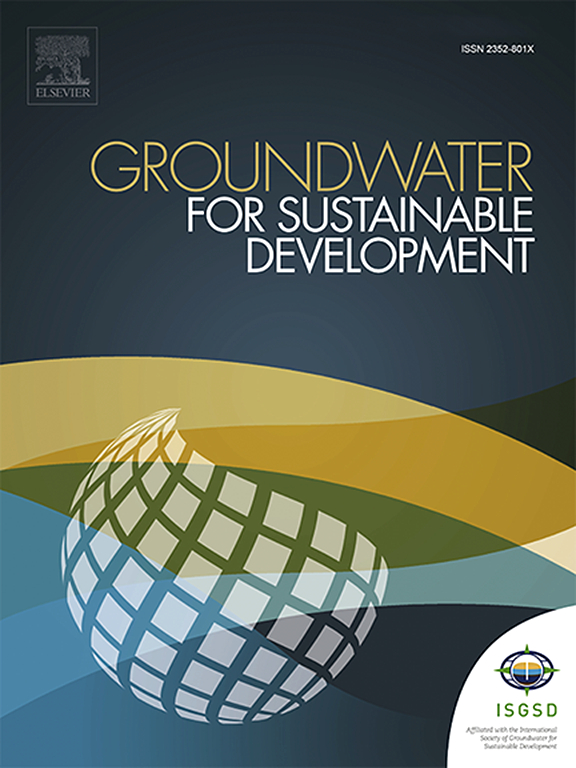Assessing the health costs of arsenic-contaminated drinking water in Bihar, India: A bivariate probit analysis
IF 4.9
Q2 ENGINEERING, ENVIRONMENTAL
引用次数: 0
Abstract
Arsenic, classified as a group I carcinogen, is naturally present in groundwater. Exposure to arsenic-contaminated groundwater poses severe health and socioeconomic challenges, such as increased healthcare costs, reduced productivity, and loss of wages and income. Hence, estimating health costs is crucial for research and policy analysis. In this context, by collecting primary data from 300 households in 12 villages consisting of three sampled blocks of Buxar district, Bihar, the present study aims to assess the incidence of illness for affected households caused by arsenic exposure, highlighting averting strategies adopted by them, and to measure the associated health costs incurred. It employs a seemingly unrelated bivariate probit model (SUBP) to estimate the health costs of arsenic-contaminated drinking water. Following the Household Production Function framework, this study jointly estimates the likelihood of sickness from arsenic-related diseases and averting behaviour. It is estimated that 72.19 persons per thousand are experiencing arsenic-related issues. Moreover, preventive strategies are followed by almost 63% of households, whereas remedial strategies which involve direct monetary cost are only followed by 23% of households. It also finds that sickness from drinking arsenic-contaminated water is positively associated with arsenic exposure, getting water from low-layer tube wells and work loss. Additionally, a positive relationship exists between work loss due to illness and averting behaviour, whereas a negative relationship exists between sickness and averting behaviour. The monthly health cost for affected households, including medical expenses (₹244.3 or USD3.28) and wage loss to illness (₹218.34 or USD2.93), is ₹462.64 (USD6.21). These findings underscore the substantial economic burden of arsenic contamination on affected households and highlight the need for targeted policy interventions. Specifically, interventions could include subsidising the cost of technology-based equipment like arsenic filters to targeted income groups, installing community-based arsenic removal units, providing health insurance, enforcing groundwater regulations and creating mass awareness.

评估印度比哈尔邦砷污染饮用水的健康成本:双变量概率分析
砷被列为一类致癌物,自然存在于地下水中。暴露于砷污染的地下水会带来严重的健康和社会经济挑战,例如医疗费用增加、生产力降低以及工资和收入损失。因此,估计卫生费用对研究和政策分析至关重要。在此背景下,本研究通过收集比哈尔邦Buxar区3个抽样街区的12个村庄300户家庭的原始数据,旨在评估受影响家庭因接触砷而引起的疾病发生率,重点介绍他们采取的预防策略,并衡量相关的卫生费用。它采用看似无关的双变量概率模型(SUBP)来估计砷污染饮用水的健康成本。根据家庭生产功能框架,本研究共同估计了因砷相关疾病和避免行为而患病的可能性。据估计,每千人中有72.19人患有与砷有关的问题。此外,几乎63%的家庭遵循预防策略,而涉及直接货币成本的补救策略仅被23%的家庭遵循。研究还发现,饮用受砷污染的水导致的疾病与砷暴露、从低层管井取水和失业呈正相关。此外,疾病导致的失业与回避行为之间存在积极关系,而疾病与回避行为之间存在消极关系。受影响家庭的每月医疗费用,包括医疗费用(244.3卢比或3.28美元)和疾病工资损失(218.34卢比或2.93美元),为462.64卢比(6.21美元)。这些发现强调了砷污染给受影响家庭带来的巨大经济负担,并强调了有针对性的政策干预的必要性。具体地说,干预措施可以包括向目标收入群体补贴以技术为基础的设备(如砷过滤器)的成本,安装以社区为基础的除砷装置,提供健康保险,执行地下水法规和提高大众意识。
本文章由计算机程序翻译,如有差异,请以英文原文为准。
求助全文
约1分钟内获得全文
求助全文
来源期刊

Groundwater for Sustainable Development
Social Sciences-Geography, Planning and Development
CiteScore
11.50
自引率
10.20%
发文量
152
期刊介绍:
Groundwater for Sustainable Development is directed to different stakeholders and professionals, including government and non-governmental organizations, international funding agencies, universities, public water institutions, public health and other public/private sector professionals, and other relevant institutions. It is aimed at professionals, academics and students in the fields of disciplines such as: groundwater and its connection to surface hydrology and environment, soil sciences, engineering, ecology, microbiology, atmospheric sciences, analytical chemistry, hydro-engineering, water technology, environmental ethics, economics, public health, policy, as well as social sciences, legal disciplines, or any other area connected with water issues. The objectives of this journal are to facilitate: • The improvement of effective and sustainable management of water resources across the globe. • The improvement of human access to groundwater resources in adequate quantity and good quality. • The meeting of the increasing demand for drinking and irrigation water needed for food security to contribute to a social and economically sound human development. • The creation of a global inter- and multidisciplinary platform and forum to improve our understanding of groundwater resources and to advocate their effective and sustainable management and protection against contamination. • Interdisciplinary information exchange and to stimulate scientific research in the fields of groundwater related sciences and social and health sciences required to achieve the United Nations Millennium Development Goals for sustainable development.
 求助内容:
求助内容: 应助结果提醒方式:
应助结果提醒方式:


